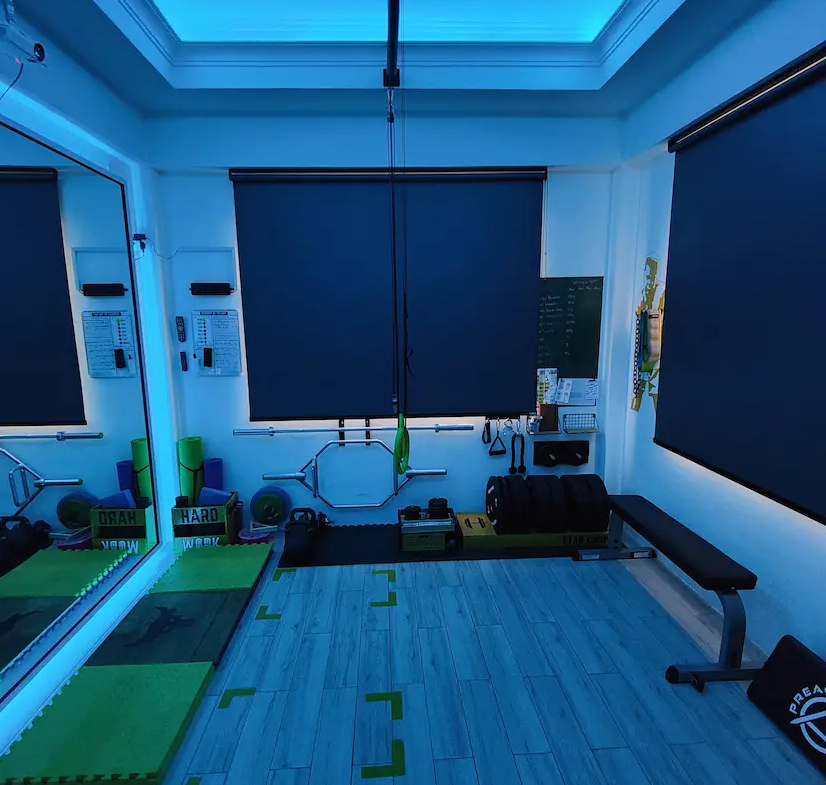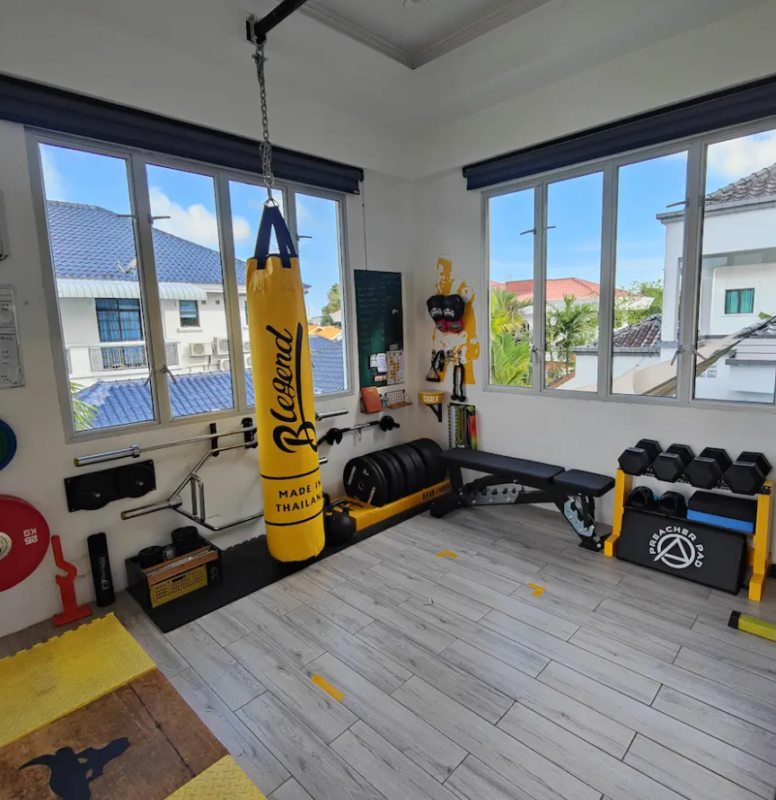Muay Thai Equipment
Setting Up a Home Gym with Muay Thai Equipment
Choosing the Right Space
Assessing Space Requirements
When setting up a home gym for Muay Thai, the first step is to choose the right space. Ideally, you need a space that allows for unrestricted movement, as Muay Thai involves a lot of dynamic actions such as kicks, punches, and footwork. A minimum area of 10×10 feet is recommended, but larger spaces provide more comfort and safety.
Indoor vs. Outdoor Spaces
Decide whether an indoor or outdoor space is more suitable for your setup. Indoor spaces are convenient and protected from weather elements, while outdoor areas offer more ventilation and natural light. Ensure the chosen space has a level floor and adequate height clearance, especially if you plan to hang a heavy bag.
Essential Muay Thai Equipment
Heavy Bag
A heavy bag is a cornerstone of Muay Thai training. It allows you to practice strikes, improve power, and refine techniques. Opt for a high-quality, durable bag that can withstand intense workouts.
Thai Pads and Focus Mitts
Thai pads and focus mitts are essential for partner drills. They help in honing striking accuracy, combinations, and defensive maneuvers. Invest in pads with sufficient padding and strong handles for safe and effective training.
Shin Guards
Shin guards are crucial for practicing kicks safely. Look for well-padded guards that provide comprehensive coverage and secure fit to prevent injuries.
Gloves and Hand Wraps
Muay Thai gloves protect your hands during bag work and sparring. Hand wraps offer additional support and cushioning, reducing the risk of injury. Choose gloves with adequate padding and wraps that are easy to use and maintain.
Flooring and Safety Measures
Appropriate Flooring Options
Flooring is a critical aspect of your home gym. Mats or rubber flooring provide cushioning, reduce impact, and prevent injuries. They also protect the underlying floor from damage caused by heavy equipment.
Safety Precautions
Ensure the space is free from hazards. Remove any sharp objects, secure loose cables, and maintain proper ventilation. Install mirrors if possible, as they help in monitoring form and technique during training.
Installation and Setup
Hanging Heavy Bags
Properly hanging your heavy bag is crucial for safety and effectiveness. Use strong brackets or ceiling mounts and ensure they are securely fastened. Check the bag’s height and adjust it to your preferred striking level.
Storing Equipment
Organize your equipment to maximize space and efficiency. Use shelves, hooks, or storage bins to keep everything in order. This not only keeps your gym tidy but also prolongs the life of your gear.
Setting Up Training Stations
Create designated areas for different training activities. For instance, have a corner for bag work, another for pad drills, and a space for strength and conditioning exercises. This structured setup enhances your training flow and focus.
Training Accessories
Skipping Rope
A skipping rope is a versatile tool for improving cardiovascular fitness, footwork, and coordination. It’s compact, affordable, and essential for any Muay Thai gym.
Resistance Bands and Medicine Ball
Resistance bands help in strength training and flexibility exercises. A medicine ball is excellent for core workouts and explosive power drills.
Timer
A timer is vital for interval training and ensuring you stick to structured rounds. Digital timers with audible alarms are particularly useful.

Maintaining Your Equipment
Cleaning and Storage Tips
Regularly clean your equipment to maintain hygiene and extend its lifespan. Wipe down gloves, pads, and mats after each session. Store gear in a cool, dry place to prevent damage from moisture and bacteria.
Equipment Longevity
Inspect your equipment frequently for wear and tear. Replace worn-out gear promptly to ensure safety and effectiveness. Investing in quality products and proper maintenance can save money in the long run.
Creating a Training Routine
Structuring Workouts
Design a balanced training routine that includes warm-ups, technique drills, bag work, pad drills, and conditioning exercises. Mix up the sessions to keep them engaging and comprehensive.
Balancing Techniques and Conditioning
Focus equally on technical skills and physical conditioning. Muay Thai requires both precise technique and robust physical fitness. Allocate time for both aspects in your training plan.
Staying Motivated
Setting Goals
Set short-term and long-term goals to keep yourself motivated. Whether it’s mastering a new technique or improving stamina, having clear objectives gives you something to strive for.
Tracking Progress
Keep a training journal or use apps to track your progress. Monitoring your improvements helps in identifying areas for development and celebrating achievements.
Creating an Inspiring Environment
Decorate your gym with motivational posters, quotes, and personal milestones. An inspiring environment can boost your morale and make your workouts more enjoyable.
Advanced Equipment Options
Speed Bag and Double End Bag
Once you’ve mastered the basics, consider adding advanced equipment like a speed bag for hand-eye coordination and a double end bag for reflexes and timing.
Sparring Gear
If you have a training partner, invest in sparring gear such as headgear, mouthguards, and groin protectors. Sparring is an integral part of Muay Thai training, providing real-time practice of techniques.
Budgeting for Your Home Gym
Cost Considerations
Setting up a home gym can be done on various budgets. Prioritize essential equipment first and add more as you go. Look for quality gear that offers durability and functionality.
DIY Options
For those on a tighter budget, consider DIY options. For instance, you can make a heavy bag using old clothes and a sturdy bag. There are numerous online tutorials for creating affordable and effective training tools.
Prioritizing Purchases
Start with the basics: gloves, hand wraps, and a heavy bag. Gradually expand your setup with additional gear like Thai pads and conditioning equipment as your training progresses.
Benefits of a Home Muay Thai Gym
Convenience
Having a home gym eliminates travel time and makes it easier to fit training into your schedule. You can train whenever it suits you, providing greater flexibility and consistency.
Customization
A home gym allows you to tailor the environment to your preferences. Choose the equipment, layout, and ambiance that best suit your training style and needs.
Personal Progress
Training at home fosters a focused and personal approach to Muay Thai. You can progress at your own pace, revisit techniques, and refine skills without external pressures.
FAQs
What is the best flooring for a Muay Thai home gym?
- Rubber mats or interlocking foam tiles are ideal, providing cushioning and protection.
How do I maintain my Muay Thai equipment?
- Regularly clean and store your gear properly. Inspect for wear and replace as needed.
Can I set up a Muay Thai gym in a small space?
- Yes, even a small space can be effective with careful planning and minimal essential equipment.
What are the must-have items for a Muay Thai home gym?
- Gloves, hand wraps, a heavy bag, Thai pads, and shin guards are essential for starting.
How can I stay motivated to train at home?
- Set goals, track your progress, and create an inspiring training environment.
Is advanced equipment necessary for beginners?
- No, beginners should start with the basics and gradually incorporate advanced equipment as they progress.
Conclusion
Setting up a home gym with Muay Thai equipment is a rewarding investment in your health and martial arts journey. By carefully selecting the right space, essential gear, and maintaining a motivating environment, you can create a personalized training sanctuary that supports your Muay Thai aspirations. Enjoy the convenience, customization, and personal growth that come with training at home.

